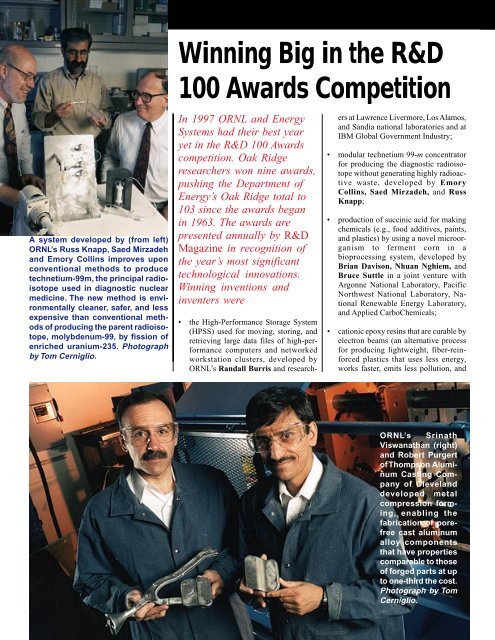Winning Big in the R&D 100 Awards Competition - Oak Ridge ...
Winning Big in the R&D 100 Awards Competition - Oak Ridge ...
Winning Big in the R&D 100 Awards Competition - Oak Ridge ...
You also want an ePaper? Increase the reach of your titles
YUMPU automatically turns print PDFs into web optimized ePapers that Google loves.
State of <strong>the</strong> Laboratory<br />
A system developed by (from left)<br />
ORNL’s Russ Knapp, Saed Mirzadeh<br />
and Emory Coll<strong>in</strong>s improves upon<br />
conventional methods to produce<br />
technetium-99m, <strong>the</strong> pr<strong>in</strong>cipal radioisotope<br />
used <strong>in</strong> diagnostic nuclear<br />
medic<strong>in</strong>e. The new method is environmentally<br />
cleaner, safer, and less<br />
expensive than conventional methods<br />
of produc<strong>in</strong>g <strong>the</strong> parent radioisotope,<br />
molybdenum-99, by fission of<br />
enriched uranium-235. Photograph<br />
by Tom Cerniglio.<br />
62<br />
<strong>W<strong>in</strong>n<strong>in</strong>g</strong> <strong>Big</strong> <strong>in</strong> <strong>the</strong> R&D<br />
<strong>100</strong> <strong>Awards</strong> <strong>Competition</strong><br />
In 1997 ORNL and Energy<br />
Systems had <strong>the</strong>ir best year<br />
yet <strong>in</strong> <strong>the</strong> R&D <strong>100</strong> <strong>Awards</strong><br />
competition. <strong>Oak</strong> <strong>Ridge</strong><br />
researchers won n<strong>in</strong>e awards,<br />
push<strong>in</strong>g <strong>the</strong> Department of<br />
Energy’s <strong>Oak</strong> <strong>Ridge</strong> total to<br />
103 s<strong>in</strong>ce <strong>the</strong> awards began<br />
<strong>in</strong> 1963. The awards are<br />
presented annually by R&D<br />
Magaz<strong>in</strong>e <strong>in</strong> recognition of<br />
<strong>the</strong> year’s most significant<br />
technological <strong>in</strong>novations.<br />
<strong>W<strong>in</strong>n<strong>in</strong>g</strong> <strong>in</strong>ventions and<br />
<strong>in</strong>venters were<br />
• <strong>the</strong> High-Performance Storage System<br />
(HPSS) used for mov<strong>in</strong>g, stor<strong>in</strong>g, and<br />
retriev<strong>in</strong>g large data files of high-performance<br />
computers and networked<br />
workstation clusters, developed by<br />
ORNL’s Randall Burris and research-<br />
ers at Lawrence Livermore, Los Alamos,<br />
and Sandia national laboratories and at<br />
IBM Global Government Industry;<br />
• modular technetium 99-m concentrator<br />
for produc<strong>in</strong>g <strong>the</strong> diagnostic radioisotope<br />
without generat<strong>in</strong>g highly radioactive<br />
waste, developed by Emory<br />
Coll<strong>in</strong>s, Saed Mirzadeh, and Russ<br />
Knapp;<br />
• production of succ<strong>in</strong>ic acid for mak<strong>in</strong>g<br />
chemicals (e.g., food additives, pa<strong>in</strong>ts,<br />
and plastics) by us<strong>in</strong>g a novel microorganism<br />
to ferment corn <strong>in</strong> a<br />
bioprocess<strong>in</strong>g system, developed by<br />
Brian Davison, Nhuan Nghiem, and<br />
Bruce Suttle <strong>in</strong> a jo<strong>in</strong>t venture with<br />
Argonne National Laboratory, Pacific<br />
Northwest National Laboratory, National<br />
Renewable Energy Laboratory,<br />
and Applied CarboChemicals;<br />
• cationic epoxy res<strong>in</strong>s that are curable by<br />
electron beams (an alternative process<br />
for produc<strong>in</strong>g lightweight, fiber-re<strong>in</strong>forced<br />
plastics that uses less energy,<br />
works faster, emits less pollution, and<br />
ORNL’s Sr<strong>in</strong>ath<br />
Viswanathan (right)<br />
and Robert Purgert<br />
of Thompson Alum<strong>in</strong>um<br />
Cast<strong>in</strong>g Company<br />
of Cleveland<br />
developed metal<br />
compression form<strong>in</strong>g,<br />
enabl<strong>in</strong>g <strong>the</strong><br />
fabrication of porefree<br />
cast alum<strong>in</strong>um<br />
alloy components<br />
that have properties<br />
comparable to those<br />
of forged parts at up<br />
to one-third <strong>the</strong> cost.<br />
Photograph by Tom<br />
Cerniglio.<br />
<strong>Oak</strong> <strong>Ridge</strong> National Laboratory REVIEW
ORNL’s Amy D<strong>in</strong>dal and Mike Sigman<br />
developed methylated sol-gel sorbent,<br />
a product for detect<strong>in</strong>g airborne<br />
pollutants such as carc<strong>in</strong>ogens and<br />
<strong>in</strong>dustrial effluents. Because of its<br />
chemical and <strong>the</strong>rmal stability, <strong>the</strong><br />
new product is expected to do <strong>the</strong> job<br />
more efficiently and at lower cost<br />
than air sampl<strong>in</strong>g traps on <strong>the</strong> market.<br />
Photograph by Tom Cerniglio.<br />
may be less costly than conventionally<br />
used <strong>the</strong>rmal cur<strong>in</strong>g), developed by<br />
Chris Janke, George Dorsey (Y-12<br />
Plant), Stephen Havens (ORISE), and<br />
V<strong>in</strong>cent Lopata (Atomic Energy of<br />
Canada);<br />
• methylated sol-gel sorbent for detect<strong>in</strong>g<br />
airborne carc<strong>in</strong>ogens and o<strong>the</strong>r <strong>in</strong>dustrial<br />
pollutants, developed by Michael<br />
Sigman, Amy D<strong>in</strong>dal, and George<br />
Wachob of Supelco Incorporated;<br />
• metal compression form<strong>in</strong>g used to<br />
make possible pore-free cast alum<strong>in</strong>um<br />
alloy components that have properties<br />
comparable to those of forged parts at<br />
up to one-third <strong>the</strong> cost, developed by<br />
ORNL’s Randall Burris teamed with<br />
researchers at Lawrence Livermore,<br />
Los Alamos, and Sandia national laboratories<br />
and at IBM Global Government<br />
Industry to develop <strong>the</strong><br />
High-Performance Storage System<br />
(HPSS). HPSS is designed to manage<br />
enormous amounts of data produced<br />
and used <strong>in</strong> modern high-performance<br />
comput<strong>in</strong>g, data collection<br />
and analysis, imag<strong>in</strong>g, and enterprise<br />
environments. Photograph by Tom<br />
Cerniglio.<br />
ORNL’s Robert Lauf (left) and Don Bible developed <strong>the</strong> Vari-Wave, a flexible<br />
microwave heat<strong>in</strong>g system for laboratory research, analytical test<strong>in</strong>g, and<br />
process development for <strong>in</strong>dustries produc<strong>in</strong>g or us<strong>in</strong>g advanced materials.<br />
Applications of Vari-Wave <strong>in</strong>clude process<strong>in</strong>g advanced polymers and<br />
composites, as well as cur<strong>in</strong>g adhesives and encapsulants <strong>in</strong> electronic<br />
packag<strong>in</strong>g assemblies. Photograph by Curtis Boles.<br />
Sr<strong>in</strong>ath Viswanathan and Robert<br />
Purgert (Thompson Alum<strong>in</strong>um Cast<strong>in</strong>g<br />
Company of Cleveland);<br />
• Vari-Wave, a microwave heat<strong>in</strong>g <strong>in</strong>strument<br />
that dramatically reduces cur<strong>in</strong>g<br />
time (from two hours to three m<strong>in</strong>utes)<br />
of adhesives and polymers used <strong>in</strong> <strong>the</strong><br />
production of circuit boards and components,<br />
developed by Bob Lauf, Don<br />
Bible (both of ORNL) Zak Fathi, Mike<br />
Hampton, and Ralph Stevens, all of<br />
Lambda Technologies of Morrisville,<br />
N.C.;<br />
• Enclosed Space Detection System that<br />
detects vibrations from <strong>the</strong> heartbeat of<br />
a person hid<strong>in</strong>g <strong>in</strong> a vehicle, developed<br />
by Leo Labaj, Michael Bath, Vivian<br />
Baylor, Michael Carroll, Mike Fuller,<br />
Tim Hickerson, Tom McCoig, and Richard<br />
Pack, all of <strong>the</strong> Y-12 Plant, and<br />
by ORNL’s Bill Dress and Stephen<br />
Kercel;<br />
• carbon-free metal-ceramic composite<br />
crucible for melt<strong>in</strong>g high-purity metals,<br />
such as uranium and copper, us<strong>in</strong>g <strong>in</strong>duction<br />
heat<strong>in</strong>g, developed by Marv<strong>in</strong><br />
Morrow (Y-12 Plant), James Kiggans,<br />
Jr. (ORNL), Cressie Holcombe (retired<br />
from Y-12 Plant), and Don Rexford of<br />
Blausch Precision Ceramics of Albany,<br />
New York.<br />
Numbers One and Two, 1998 63

















